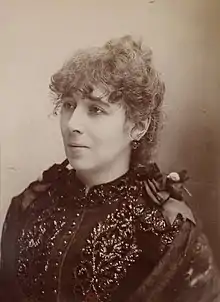Marie Huot
Marie Huot (born Mathilde Marie Constance Ménétrier; 28 June 1846 – 13 April 1930) was a French poet, writer, feminist, animal rights and vegetarianism activist.
Marie Huot | |
|---|---|
 | |
| Born | Mathilde Marie Constance Ménétrier 28 June 1846 Yonne, France |
| Died | 13 April 1930 (aged 83) Paris, France |
| Occupation | Activist, writer |
| Spouse(s) | Anatole-Théodore-Marie Huot
(m. 1869) |
Biography
Mathilde Marie Constance Ménétrier was born in 1846. In 1869, she married Anatole-Théodore-Marie Huot, the editor of the leftist Parisian review, L'Encyclopédie Contemporaine Illustrée.[1] She was a close friend of the Swedish anarchist, impressionist painter Ivan Aguéli, whom she indirectly introduced to Sufism[2] and dedicated her collection of symbolism poems Le Missel de Notre-Dame des Solitudes ("The Missal of Our Lady of Solitudes").[3]
Huot was an advocate for animal rights and member of the Parisian animal protection society,[4] founder of the Popular League against Vivisection[5] and France's first hospice for animals.[2] She was famous for a number of spectacular activist actions. In 1886, she interrupted a lecture by Louis Pasteur at the Sorbonne University, for using dogs in animal testing.[2] Once, at Collège de France, she hit the Mauritian scientist Charles-Édouard Brown-Séquard over the head with a parasol for having performed a vivisection on a monkey.[4] In 1900, she helped Ivan Aguéli in his attack on two matadors at a French bullfight.[2]
Active in the French Neo-Malthusianism movement, Huot was the originator of the expression "la gréve des ventres" ("strike of the bellies" or "birth strike").[6] In 1892, Huot delivered a public conference, in which she demanded free access to abortion and contraception.[5] At this conference, Huot also advocated for the voluntary extinction of the human race by refusal to procreate, both out of compassion for human suffering and the suffering that humans inflict on animals. This was later published, in 1909, as Le Mal de Vivre ("The Pain of Living").[7]
Selected publications
Articles
- "Le Droit des Animaux" ("Animal Law"), La Revue socialiste, Iss. 6, 1887, pp. 47–56
Books
- Le Missel de Notre-Dame des Solitudes ("The Missal of Our Lady of Solitudes") (Paris: E. Sansot, 1908) (preface by Rachilde)
- Le Mal de Vivre ("The Pain of Living") (Paris: Génération Consciente, 1909)
References
- Brecq, Mahdî (2017). "Nouveaux éclairages sur Ivan Aguéli" [New lights on Ivan Aguéli]. Cahiers de l'Unité (in French). Retrieved 2020-04-15.
- Sedgwick, Mark (2009). Against the Modern World: Traditionalism and the Secret Intellectual History of the Twentieth Century. Oxford: Oxford University Press. pp. 60–61. ISBN 978-0-19-539601-0.
- Brecq, Mahdî (2018). "Nouveaux éclairages sur Ivan Aguéli (III)" [New insights into Ivan Aguéli (III)]. Cahiers de l'Unité (in French). Retrieved 2020-04-15.
À mon frère d’armes, à l’artiste fervent Ivan Aguéli (en religion Abdul Hâdi) [To my brother in arms, to the 'fervent artist Ivan Aguéli (in religion Abdul Hâdi)']
- Kete, Kathleen (1994). The Beast in the Boudoir: Petkeeping in Nineteenth-century Paris. Berkeley, California: University of California Press. p. 16. ISBN 978-0-520-07101-8.
- Traïni, Christophe (2016), "(Animal) victims and social domination", The Animal Rights Struggle, An Essay in Historical Sociology, Amsterdam University Press, pp. 125–156, ISBN 978-90-8964-849-5, JSTOR j.ctt1jd94gh.10
- Martínez-Alier, Joan (2003). The Environmentalism of the Poor: A Study of Ecological Conflicts and Valuation. 51: Edward Elgar Publishing. ISBN 978-1-84376-548-6.CS1 maint: location (link)
- Huot, Marie (1909). Le Mal de Vivre. Paris: Génération Consciente.